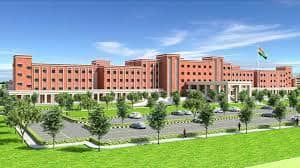- Adding 2,500 beds to the hospital
- Upgrading the hospital to a 2,500-bed super-specialty facility
- Educational opportunities
- To boost the local economy, create new jobs
- To improve the quality of life for all residents
- Completing the project in 24 months
- Qualifying NCC & L&T for technical bidding
KBC 2023 Registration via PLAY ALONG QUIZ MARATHON
KBC 2023 Registration via PLAY ALONG MARATHON - 24 Hours QUIZ Marathon for all.
Darbhanga IT-Park Software Hub
Darbhanga IT-Park is under construction pretty soon, City Darbhanga will have latest IT-Park with laced with new tech.
IndiGo to start flights for Kolkata, Hyderabad from July 5
Great News for Darbhanga City, As Indigo has announced that Flight for Kolkata and Hyderabad will start from July 5th.
Darbhanga Airport Started Flight Service
Darbhanga Airport Flight Service started on November 8th, 2020.
VEENA VATIKA - A Dream Township in Darbhanga
Great news for all - Darbhanga's first Township Project - VEENA VATIKA started Booking.
A New DMCH, Darbhanga for a New Darbhanga
The Motor Vehicle Act: Promoting Safe and Orderly Traffic Flow in India
The Motor Vehicle Act - In India, the primary piece of legislation governing every facet of motor vehicles is the Motor Vehicle Act (MVA). Encouraging safe and efficient traffic movement on the vast road network of the nation is its main objective. In addition to enforcing the law, the MVA raises public awareness of safe driving practices through marketing and educational initiatives. The Act is a living document that is updated to meet evolving requirements. Stricter penalties, streamlined car registration procedures, and the incorporation of modern technology for improved enforcement have been the main focuses of recent changes. An essential factor in guaranteeing the effectiveness and safety of India's transportation network is the Motor Vehicle Act.
The Motor Vehicle Act's Long-term Journey - India's busy roadways and the development of the Motor Vehicle Act (MVA) go back a long way. A peek into its intriguing journey can be found here:
Early Days: Regulating a New Invention (1914) - The Indian Motor Vehicles Act of 1914, which was passed during British India, was the first law in India to control the usage of motor vehicles. The first MVA was enacted in 1914, marking the beginning of the tale. In those days, automobiles were a fresh concept in India. With just eighteen parts, the original Act gave local governments the authority to oversee driver license, vehicle registration, and other fundamental laws in order to maintain some kind of order.
A More Robust Framework (MV Act 1939 & MV Act 1988) - A more extensive framework became necessary as the number of cars increased. The Road Traffic Act of 1934, often known as the MV Act, is a law that renders some policy conditions void and obliges insurers to comply with judgments rendered against the insured. The 1939 MVA superseded the previous one, bringing in more centralized administration and stringent restrictions. This opened the door for the 1988 MVA, which served as the basis for the laws that are in place today. The MV 1988 Act addressed various aspects like:
- Licensing: Standardized procedures for driver and conductor licenses.
- Registration: Mandatory registration of all motor vehicles.
- Insurance: Made at least third-party insurance mandatory for vehicle registration.
- Traffic Regulation: Established uniform traffic rules across the country.
- Offences and Penalties: Outlined a system of fines and penalties for traffic violations.
Responding to Changing Needs (MV Act 2019 Amendment) - A substantial MVA change was proposed in 2019. This was an attempt to address India's growing concerns regarding road safety. The Motor Vehicles (Amendment) Bill, 2019 was presented to the Lok Sabha on July 15, 2019, by Mr. Nitin Gadkari, the Minister of Road Transport and Highways. The purpose of the bill is to add provisions for road safety to the Motor Vehicles Act of 1988. The Act establishes criteria for motor vehicles, the granting of licenses and permits associated with them, and the penalties for breaking these rules. Important alterations comprised:
- Enhanced Road Safety: The Act aimed to improve road safety by introducing stricter penalties for traffic violations. These included hefty fines for offenses like driving under the influence, speeding, and not wearing seatbelts.
- Focus on Vulnerable Users: The amendment placed greater emphasis on protecting pedestrians, cyclists, and two-wheeler riders, who are more susceptible to accidents.
- Streamlining Processes: The Act introduced provisions for online driver's license issuance and renewal, improving efficiency and potentially reducing opportunities for fraud.
- Technological Advancements: The legislation opened doors for integrating new technologies for better traffic management. This could include electronic challans (fines) and improved enforcement mechanisms.
- Increased Accountability: The amendment held road contractors accountable for faulty road design and construction, aiming to improve overall road infrastructure.
The MVA's Legacy: A Work in Progress - The Motor Vehicle Act has undergone constant modification to address the demands of India's dynamic transportation environment. Its emphasis on law and order, safety, and sensible driving practices never wavers. The MVA will probably continue to be updated in order to provide a safer and more effective road network for everybody, as traffic trends and technological advancements evolve.

















